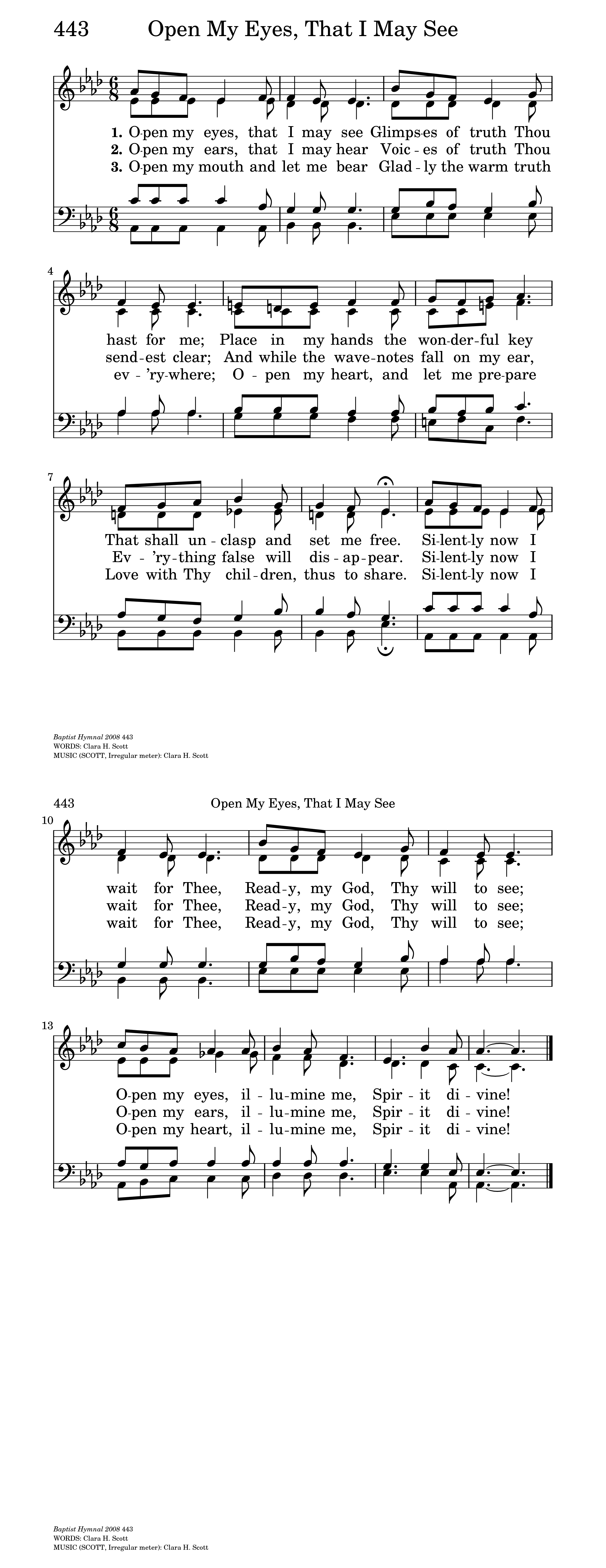glimpses of truth Thou hast for me;
place in my hands the wonderful key,
that shall unclasp and set me free.
Silently now I wait for Thee,
ready, my God, Thy will to see;
open my eyes, illumine me,
Spirit divine!
2. Open my ears, that I may hear
voices of truth Thou sendest clear;
and while the wave-notes fall on my ear,
ev’rything false will disappear.
Silently now I wait for Thee,
ready, my God, Thy will to see;
open my ears, illumine me,
Spirit divine!
3. Open my mouth, and let me bear
gladly the warm truth ev’rywhere;
Open my heart, and let me prepare
love with Thy children thus to share.
Silently now I wait for Thee,
ready, my God, Thy will to see;
open my mouth, illumine me,
Spirit divine!
The hymn "Open My Eyes, That I May See" was written by Clara H. Scott in 1895, the same year she tragically passed away. A gifted composer, poet, and musician, Clara Scott was one of the first women in America to publish a volume of anthems for choirs. She was born in Elk Grove, Illinois, in 1841, and her life was devoted to music, teaching, and spiritual songwriting. With a deep Christian faith and a love for sacred music, she sought to uplift souls through song.
This particular hymn was inspired by Psalm 119:18, which says, “Open thou mine eyes, that I may behold wondrous things out of thy law.” This verse captures the prayerful heart of the believer who longs to receive divine insight—not just physical sight, but spiritual understanding. Scott’s lyrics reflect this yearning. Each stanza opens with a plea: "Open my eyes," "Open my ears," and "Open my mouth." These are more than sensory requests; they are spiritual aspirations to perceive God more clearly, hear His truth more faithfully, and speak His praise more sincerely.
The hymn was composed during a period when the American church was undergoing a deepening of spiritual expression, and hymns were increasingly becoming prayers in themselves. Unlike many hymns focused on doctrine or proclamation, "Open My Eyes, That I May See" is introspective and meditative. It's a quiet surrender, a hymn of spiritual consecration. The gentle tone and simple structure make it deeply personal, almost like a private prayer set to music.
The tune was also composed by Clara Scott herself. Its flowing melody complements the reflective nature of the lyrics. It's neither bombastic nor dramatic, but calm and tender, inviting quiet meditation and reverence. This made it a favorite for moments of devotion, prayer meetings, and altar calls. The music and words are perfectly matched in their spirit of submission and desire for divine enlightenment.
Tragically, Clara Scott died shortly after composing this hymn. She was thrown from a carriage in a freak accident involving a frightened horse, marking a sudden end to a promising and impactful life. She never saw the long-lasting legacy her hymn would have. Though she wrote other music and hymns, "Open My Eyes, That I May See" remains her most enduring work. Its message continues to resonate with generations of Christians longing for deeper spiritual understanding.
The hymn’s legacy lies in its timeless relevance. In every age, believers face distractions, spiritual dullness, and confusion. Clara Scott's prayer—quiet and sincere—is as vital today as it was in 1895. With each verse, she reminds us that spiritual clarity comes not by human effort, but by divine revelation. And so, when we sing this hymn, we join her in that simple yet profound request: "Open my eyes, that I may see..."
It is fitting that Clara’s final published work was one that asked for spiritual vision. Her own eyes were closed to this world shortly after, but she left behind a hymn that has helped countless others open theirs—to truth, to beauty, and to God.



No comments:
Post a Comment